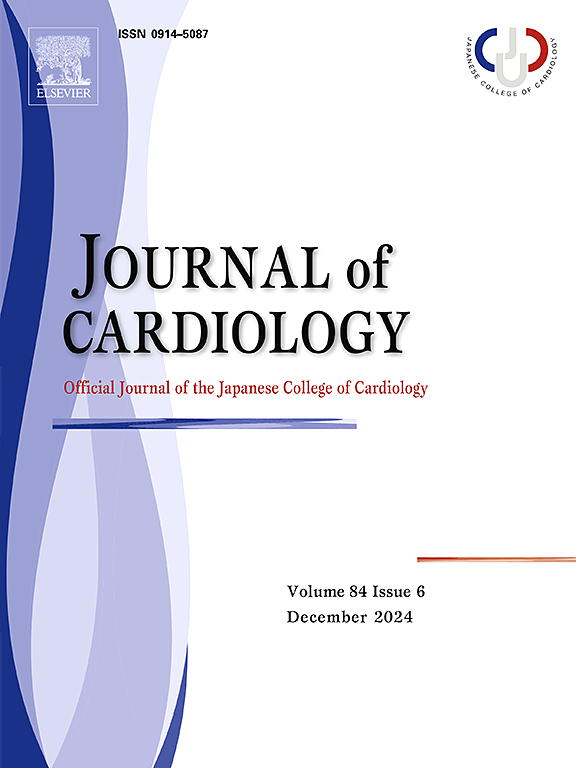Optimal ablation pattern on intraprocedural echocardiography is associated with favorable clinical outcomes of alcohol septal ablation for hypertrophic obstructive cardiomyopathy
IF 2.6
3区 医学
Q2 CARDIAC & CARDIOVASCULAR SYSTEMS
引用次数: 0
Abstract
Background
Alcohol septal ablation (ASA) is used to treat drug-refractory hypertrophic obstructive cardiomyopathy (HOCM). Intraprocedural echocardiography is essential for identifying the septal area perfused by each septal branch; however, its role in determining the procedural endpoint of ASA remains unclear. This retrospective study aimed to evaluate the impact of intraprocedural echocardiographic findings on clinical outcomes and left ventricular pressure gradient (LVPG) after ASA.
Methods
Overall, 120 patients with HOCM who underwent ASA at a single center were divided into two groups based on the presence of optimal ablation. Optimal ablation was defined as the ablated area fully covering the targeted septal myocardium from the point of contact with the onset of the accelerated flow to the basal septum and dense acoustic shadowing accompanying the ablated area. Clinical outcomes and LVPG changes were evaluated using inverse probability of treatment weighting.
Results
Significantly more patients showed a New York Heart Association (NYHA) functional class improvement of ≥2 stages or achievement of class I in the optimal ablation group (n = 74) than in the non-optimal ablation group (94 % vs. 62 %; p < 0.001). The optimal ablation group had a significantly greater percentage reduction in LVPG at 1-year after ASA (82 ± 18 % vs. 64 ± 18 %; p = 0.001). Multivariate analyses revealed that optimal ablation was an independent predictor of a NYHA functional class improvement of ≥2 stages or achievement of class I (odds ratio, 11.3; 95 % confidence interval, 3.43–39.1; p < 0.001) and a percentage reduction in LVPG (p = 0.001).
Conclusions
Intraprocedural echocardiographic findings of optimal ablation were associated with favorable clinical outcomes and a significant reduction in LVPG.

术中超声心动图的最佳消融模式与肥厚性梗阻性心肌病酒精室间隔消融的良好临床结果相关。
背景:酒精室间隔消融术(ASA)用于治疗药物难治性肥厚性阻塞性心肌病(HOCM)。术中超声心动图对确定每条间隔分支灌注的间隔区域至关重要;然而,其在决定ASA的程序性终点中的作用尚不清楚。本回顾性研究旨在评估术中超声心动图结果对ASA后临床结果和左心室压力梯度(LVPG)的影响。方法:总体而言,120例在单一中心接受ASA的HOCM患者根据是否存在最佳消融分为两组。最佳消融定义为消融区域从基底隔加速血流开始的接触点起完全覆盖靶间隔心肌,且消融区域伴有密集的声影。采用治疗加权逆概率法评估临床结果和LVPG变化。结果:最佳消融组(n = 74)的纽约心脏协会(NYHA)功能分级改善≥2期或达到I级的患者明显多于非最佳消融组(94 %对62 %;p 结论:最佳消融术的术中超声心动图结果与良好的临床结果和LVPG的显著降低相关。
本文章由计算机程序翻译,如有差异,请以英文原文为准。
求助全文
约1分钟内获得全文
求助全文
来源期刊

Journal of cardiology
CARDIAC & CARDIOVASCULAR SYSTEMS-
CiteScore
4.90
自引率
8.00%
发文量
202
审稿时长
29 days
期刊介绍:
The official journal of the Japanese College of Cardiology is an international, English language, peer-reviewed journal publishing the latest findings in cardiovascular medicine. Journal of Cardiology (JC) aims to publish the highest-quality material covering original basic and clinical research on all aspects of cardiovascular disease. Topics covered include ischemic heart disease, cardiomyopathy, valvular heart disease, vascular disease, hypertension, arrhythmia, congenital heart disease, pharmacological and non-pharmacological treatment, new diagnostic techniques, and cardiovascular imaging. JC also publishes a selection of review articles, clinical trials, short communications, and important messages and letters to the editor.
 求助内容:
求助内容: 应助结果提醒方式:
应助结果提醒方式:


